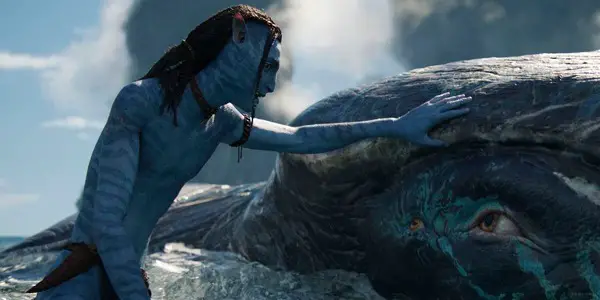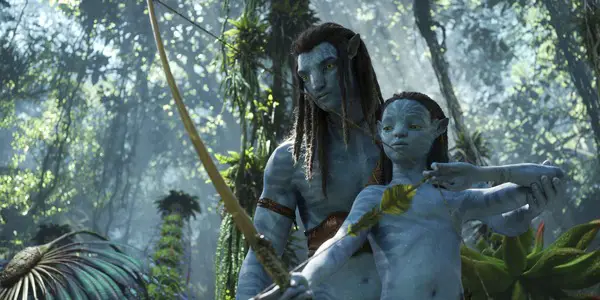AVATAR: THE WAY OF WATER: A Demo Reel of Cinema’s Possible Future
Soham Gadre is a writer/filmmaker in the Washington D.C. area.…
I’m probably never going to see James Cameron’s Avatar: The Way of Water ever again. At least, not unless it re-releases again in 3D IMAX the way that the first Avatar did in anticipation of the second. Or perhaps I get rich enough to afford my own home theater with a 3D-compatible projector screen. The thing about Cameron’s life project, one that is perhaps going to play out for the rest of his career, is that it is marginally one of storytelling and instead concerns itself with scripting cinema’s possible future. The first Avatar, released twelve years ago, began the process in many theaters, with commitments from five of Hollywood’s major studios, of adopting digital projection as the default over 35mm. This in and of itself should put to rest the ahistorical argument that Avatar had “no lasting cultural impact.”
A Retread of The First Movie
I have a conflicted relationship with Avatar. I don’t find its storytelling or its characters all that important or meaningful. In The Way of Water, Jake Sully (Sam Worthington) is yet again adopting a new culture (of the Metkayina, the sea-people of Pandora) to shield himself (and this time also his family). It’s the first time Neytiri (Zoe Saldana) experiences the sort of awkward assimilation struggles that Jake experienced in the first movie. But none of this is really explored because Jake’s family is exceptional. They eventually pick up things from the cultures they’re adopting and then excel even further than the people who have been practicing them for centuries. Take Kiri (Sigourney Weaver), their adopted daughter, for example. She has secret special powers that go beyond just the Pandora natives’ spiritual connection to nature. Her brother Lo’ak (Britain Dalton) ends up befriending a Tulkan (a Pandoran whale) and shares a relationship with him deeper and more communicative than any of the Metkayina share. Jake’s family are Chosen People. They have their own version of a Manifest Destiny. They are given shelter and fed even at the risk of the death of an entire other tribe. They can go and do anything essentially that they want with minimal effort and whatever ridicule they face, will, of course, come back to bite the bullies.

This is why any tangential metaphors to indigenous peoples and environmentalism and greed and capital don’t render far deeper than being catalysts for a spectacle (and my what a spectacle!). Current cultural trends nudge people into injecting fake politics into media they consume to feel good and morally justify it because the discussion of cinema as art is no longer enough. But there’s no evidence of coherent politics in this thing (it’s by a mainstream Hollywood filmmaker after all). Quaritch (Stephen Lang) remains the only interesting character in the film precisely because he has the soul of a hot-blooded human and when it comes to them, Cameron does have some real insight – see Terminator 2. Quaritch is technically dead but is brought back in a Na’avi Avatar form (see Terminator 2, again) that gives him an actually potent personal identity crisis. One which considers the way memory shapes a person. His problem can’t be answered by Eywa. So is Quaritch still Quaritch? Towards the end of the film, he shows a millisecond of having a heart when he sees his son Spider (Jack Champion) might actually die at the hands of Neytiri. It’s the only plot point development I’m eagerly anticipating for Avatar 3.
A New Frontier for Digital Filmmaking
Most if not all of what is memorable and important about the Avatar films is how it’s made and how it looks. The way the film is designed, the way it dedicates itself to engulfing you in the physical realm of what Cameron creates is its strength and that’s important and maybe even indispensable in an age where the cinematic image needs to be re-established as a fundamental element of movies. Cameron is a master of action sequences and inspiring emotion from pageantry. He spends a lot of time in The Way of Water showing off its oceans, beaches, reefs, skies, and forests to us. Several stretches of the movie show the kids swimming, dancing, and discovering new places and creatures, all wordlessly, eyes filled with wonder. So do we, because the 3D technology and incredibly painstaking visual effects create a seamless reality that sucks you in. I had to remind myself multiple times that nothing on the screen actually exists. You can’t help but just believe in the authenticity of what is being shown.

When the kids are chased by various entities throughout the film, the frame often dodges between reefs, and inside crevices, and fluctuates from enclosed to exposed spaces that perfectly relay their vulnerability in open waters. When the Mother Tree is destroyed in Avatar, it’s probably the apex of the visual mise-en-scene that Cameron creates in the first film. The emotions that result in the faces and eyes of Na’avi, the reflection of the slow toppling of the flaming forest before them, are great feats of special effects achievement and it’s a testament to how “real” Pandora feels as a place. Likewise, the ending war sequence in The Way of Water where the Metkayina warriors and the Sully family attack Quaritch’s boat is where the film brings forth Cameron’s most high-octane action choreography since Terminator 2. Cameron unloads his whole bag of cinematic weaponry, where every hit, spear throw, jump, shot, and explosion take your breath as much as the last. When the Sully’s are trapped in different parts of the boat, one can’t help but notice the obvious parallels to Titanic. Cameron tilts the frames in conjunction with rapid flows of water into enclosed spaces in spaces that build desperation and claustrophobia for the characters. Again, I had to slap myself to remind myself that none of what was going on screen was real. It was all effects.
But is this spectacle empty? I don’t think what Cameron has done here, or what he has continuously done in his whole career can be considered totally empty. He is a man of grand ambition and that spills from screen to real life. His actual treks to push the boundaries of scientific exploration in the real world are manifested cinematically in the amount of dedication he has to continue creating things people have never seen before – in a purely visual sense. In a weird way, James Cameron’s Avatar intersects with Jean-Luc Godard’s Adieu au Langage (2014) in the act of manipulating and stretching the possibilities of the digital cinematic image with aid from 3D. Both of these films are heavily informed by an understanding of cinema’s place within their present culture and the visual image’s communication with an audience, all through the language of cinema.
Conclusion
As the credits rolled on The Way of Water, I came to understand that what Cameron did in 2009 was being done again and done better. He was once again redefining what cinema’s future can be in the digital and technological age. He was redefining what Pandora was visually and what the audience’s relationship to it is. Essentially, he was remaking Avatar in the guise of a sequel film that keeps its character in a time-warp of the same dilemmas over again with the aim of showcasing a new era of digital technology in movies. It’s funny in this sense… many jokes were had about Cameron re-hashing Dances with Wolves (1990) or Fern Gully (1992) or Pocahontas (1995). Avatar is probably better than all of those films. Cameron took the jokes, he saw what he accomplished, and he doubled down. He ripped off his own movie… and he made a better movie, again. It’s a demo reel for what will come over the next ten, or twenty, years of cinema.
Challenge: name one character from Avatar: The Way of Water from memory.
Answer: Who cares. The only name you need to know is James Cameron.
Avatar: The Way of Water was released in U.S. theaters on December 16, 2022
Watch Avatar: The Way of Water
Does content like this matter to you?
Become a Member and support film journalism. Unlock access to all of Film Inquiry`s great articles. Join a community of like-minded readers who are passionate about cinema - get access to our private members Network, give back to independent filmmakers, and more.
Soham Gadre is a writer/filmmaker in the Washington D.C. area. He has written for Hyperallergic, MUBI Notebook, Popula, Vague Visages, and Bustle among others. He also works full-time for an environmental non-profit and is a screener for the Environmental Film Festival. Outside of film, he is a Chicago Bulls fan and frequenter of gastropubs.












